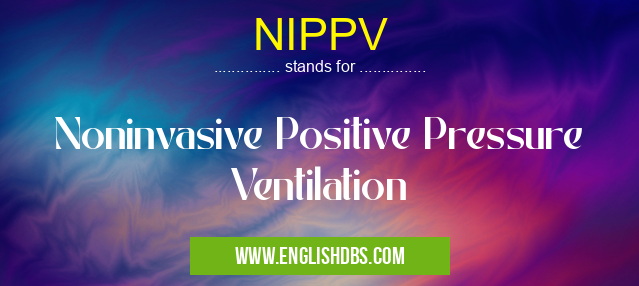What does NIPPV mean in MEDICAL
Noninvasive Positive Pressure Ventilation (NIPPV) is a type of medical ventilation therapy used to treat breathing disorders. It has become an important part of the treatment plan for many respiratory conditions such as COPD, interstitial lung diseases, neuromuscular weakness, and chest trauma. NIPPV involves using mechanical pressure to help support a patient’s airway and lungs in order to improve their breathing patterns. This type of support can provide relief from shortness of breath and other symptoms associated with respiratory distress, while also allowing the patient to remain more comfortable during treatment.

NIPPV meaning in Medical in Medical
NIPPV mostly used in an acronym Medical in Category Medical that means Noninvasive Positive Pressure Ventilation
Shorthand: NIPPV,
Full Form: Noninvasive Positive Pressure Ventilation
For more information of "Noninvasive Positive Pressure Ventilation", see the section below.
Benefits
The use of this type of ventilator has many benefits, including reducing work on breathing so patients can conserve energy while still receiving adequate oxygen levels; improving comfort levels by keeping patients from feeling like they are suffocating; improving sleep quality; reducing oxygen requirements and carbon dioxide retention; reducing hospital stays, as well as improving outcomes for people with certain types of acute respiratory failure.
Essential Questions and Answers on Noninvasive Positive Pressure Ventilation in "MEDICAL»MEDICAL"
What is Noninvasive Positive Pressure Ventilation (NIPPV)?
Noninvasive Positive Pressure Ventilation (NIPPV) is a form of respiratory support that provides positive pressure to the airway in order to improve ventilation in patients with breathing difficulties. It is an alternative to more invasive forms of ventilation such as intubation or tracheostomy, and may be used for conditions such as chronic obstructive pulmonary disease, asthma, and heart failure.
How does NIPPV work?
NIPPV works by delivering pressure-controlled breaths via either face mask or nasal cannula. The air flow rate and pressure of the ventilator are adjusted according to the patient's needs. This helps to maintain a secure airway while providing sufficient oxygenation and improving gas exchange in the lungs.
Who can benefit from NIPPV?
NIPPV can be beneficial for people with certain lung diseases or disorders such as COPD, asthma, bronchiolitis, and pneumonia who are experiencing shortness of breath or difficulty breathing. It may also be useful for people who have difficulty sustaining adequate oxygen levels due to high metabolic demand states such as after surgery or during pregnancy.
Are there any risks associated with NIPPV?
As with all medical interventions, there are potential risks associated with the use of NIPPV. These include infection, skin breakdown, abdominal distension, blood clot formation, hypothermia, and gastric insufflation (air entering into the stomach). To reduce these risks it is essential that regular monitoring and assessments are performed while using this form of ventilation support.
What type of equipment is used for NIPPV?
A range of different equipment may be used when providing NIPPV assistance including masks or nasal cannula connected to a ventilator machine that provides pressurized breaths at adjustable rates and pressures suitable for the patient's needs. In addition, humidifiers and filters may be added to help provide comfortable humidified air during treatments sessions.
Is sedation necessary when using NIPPV?
Sedation usually isn't necessary when providing respiratory support through noninvasive ventilation such as NIPPV; however it may occasionally required in order reduce levels of anxiety or discomfort caused by treatment. If sedation is needed then it will normally only be administered under close supervision by skilled practitioners experienced in both sedation techniques and noninvasive ventilation management.
How long does a typical session with NPPP last?
The duration of a typical session with NPPP varies depending on individual patient requirements but can last anywhere between minutes up to several hours per day if needed; this may even include overnight stays in some cases if clinically indicated as beneficial by medical professionals managing the treatment plan.
Is it possible to manage home care using NPPP?
Yes depending on individual circumstances it may be possible for some patients who have been deemed suitable by their healthcare provider to receive therapy at home using self-managed monitors connected an external ventilator unit under instruction medical staff experienced in dealing with noninvasive positive pressure ventilation systems.
Final Words:
In conclusion, NIPPV provides an important option for treating various forms of respiratory distress, allowing patients to receive necessary care without having to go through invasive procedures like intubation or tracheostomy placement. As medical technology progresses, NIPPV will become even more important in providing critical care for those who need it most quickly and efficiently.
